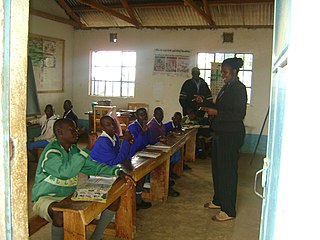
Metropolitan Manila, commonly shortened to Metro Manila and formally the National Capital Region, is the capital region and largest metropolitan area of the Philippines. Located on the eastern shore of Manila Bay, the region lies between the Central Luzon and Calabarzon regions. Encompassing an area of 636.00 km2 (245.56 sq mi) and with a population of 13,484,462 as of 2020, it is composed of sixteen highly urbanized cities: the capital city, Manila, Caloocan, Las Piñas, Makati, Malabon, Mandaluyong, Marikina, Muntinlupa, Navotas, Parañaque, Pasay, Pasig, Quezon City, San Juan, Taguig, and Valenzuela, along with one independent municipality, Pateros. As the second most populous and the most densely populated region in the Philippines, it ranks as the 9th most populous metropolitan area in Asia and the 6th most populous urban area in the world.

Makati, officially the City of Makati, is a highly urbanized city in the National Capital Region of the Philippines, known for being one of the leading financial centers in the country. As of 2013, the city has the highest concentration of multinational and local corporations in the Philippines. Major banks, corporations, department stores as well as foreign embassies are based in Makati. Makati is also known for being a major cultural and entertainment hub in Metro Manila. According to the 2020 census, it had a population of 629,616 people, making it as the 47th most populous city in the country and ranked as the 43rd most densely populated city in the world with 19,336 inhabitants per square kilometer or 50,080 inhabitants per square mile.

Pasay, officially the City of Pasay, is a highly urbanized city in the National Capital Region of the Philippines. According to the 2020 census, it has a population of 440,656 people.

The National Commission for Culture and the Arts of the Philippines is the official government agency for culture in the Philippines. It is the overall policy making body, coordinating, and grants giving agency for the preservation, development and promotion of Philippine arts and culture; an executing agency for the policies it formulates; and task to administering the National Endowment Fund for Culture and the Arts (NEFCA) – fund exclusively for the implementation of culture and arts programs and projects.

Manila Christian Computer Institute for the Deaf (MCCID) is a non-sectarian, post-secondary, Christian foundation school for the deaf in the Philippines authorized by the Technical Education and Skills Development Authority (TESDA) to offer non-degree computer and other technical training programs.

The Cultural Center of the Philippines Foundation, Inc. is a government-owned and controlled corporation established to preserve, develop and promote arts and culture in the Philippines. The CCP was established through Executive Order No. 30 s. 1966 by President Ferdinand Marcos. Although an independent institution of the Philippine government, it receives an annual subsidy and is placed under the National Commission for Culture and the Arts for purposes of policy coordination. The CCP is headed by an 11-member Board of Trustees, currently headed by Chairperson Margarita Moran-Floirendo. Its current president is Arsenio Lizaso.

Saint Scholastica's College, also referred to by its acronym SSC or colloquially St. Scho, is a private Catholic basic and higher education institution for women founded and managed by the Congregation of the Missionary Benedictine Sisters of Tutzing in a 3.66 hectares (36,600 m2) lot in Malate, Manila, Philippines. It was established in 1906 initially offering elementary academic programs. It started admitting high school students in 1907 and opened its collegiate department in 1920. It pioneered in formal music education in the Philippines, opening a Conservatory of Music in 1907.

Central Luzon State University is a state university on a 658-hectare campus in Muñoz, Nueva Ecija, Philippines. It is the lead agency of the Muñoz Science Community and the seat of the Regional Research and Development Center in Central Luzon. To date, CLSU is one of the premiere institutions for agriculture in the Philippines and in Southeast Asia known for its research in aquaculture, ruminants, crops, orchard, and water management. It has also been placed between the sixth and the twenty-first spot for the most academically-excellent university in the country for various years, surpassing most schools in Metro Manila.

Bay City, also known as the Manila Bay Freeport Zone and Manila Bay Area, is the name for the reclamation area on Manila Bay located west of Roxas Boulevard and the Manila–Cavite Expressway in Metro Manila, Philippines. The area is split between the cities of Manila and Pasay on the north side and Parañaque on the south.

The British School Manila is a private, non-profit international school in the Philippines. The school provides British education for children ages 3-18, following an adapted form of a British Curriculum and the IB Diploma. BSM students are prepared for end of Key Stage tests in Primary, GCSEs at 16, the IB Diploma at 18 and for life beyond school and university.

Filipino Sign Language (FSL) or Philippine Sign Language, is a sign language originating in the Philippines. Like other sign languages, FSL is a unique language with its own grammar, syntax and morphology; it is not based on and does not resemble Filipino or English. Some researchers consider the indigenous signs of FSL to be at risk of being lost due to the increasing influence of American Sign Language.

Deaf education is the education of students with any degree of hearing loss or deafness. This may involve, but does not always, individually-planned, systematically-monitored teaching methods, adaptive materials, accessible settings, and other interventions designed to help students achieve a higher level of self-sufficiency and success in the school and community than they would achieve with a typical classroom education. There are different language modalities used in educational setting where students get varied communication methods. A number of countries focus on training teachers to teach deaf students with a variety of approaches and have organizations to aid deaf students.
The International Deaf Education Association (IDEA) is an organization focused on educating the deaf in Bohol, Philippines initiated by the United States Peace Corps, under the leadership of Dennis Drake. The organization is a non-profit establishment that provides education to the impoverished and neglected deaf and blind children in the Philippines. The institution is able to hold special education classes on the islands of Bohol and Leyte through sponsorship program financially supported by American and European participants. Established in 1985, IDEA has the mission to give assistance to the deaf community in the Philippines in order for them to achieve self-reliance through the provision of “academic, vocational, physical, spiritual, and economic opportunities”. As a holistic ministry, IDEA aims to develop a society wherein deaf people can benefit from “social and economic equality, exchanging isolation for community, and servitude for self-reliance”.

The Asian Institute of Maritime Studies (AIMS) is a Maritime Higher Education Institution (MHEI) in Pasay, Philippines that provides highly technical learning in maritime education. It is a specialized maritime learning and research institution and considered one of the top performing maritime schools in the Philippines consistently producing top-notchers in board examinations. It was founded in 1993 by Captain Wilijado P. Abuid along with other maritime leaders to provide world-class maritime education to the Filipino youth.
Carlos D. Arguelles was a Filipino architect who was known for being a leading proponent of the International Style of architecture in the Philippines in the 1960s. He was an Eagle Scout and a Distinguished Eagle Scout Awardee of the Boy Scouts of America.
Mabel Ellery Adams was an American writer on education for children with special needs, a teacher and principal at Horace Mann School in Boston. She was a president of the Sarah Fuller House for Little Deaf Children, a member of the National Research Council at Washington on the Problems of Deaf and a member of the Committee on the Hard-of-Hearing Child. She wrote numerous articles for American Annals of the Deaf.

William R. Barry was an American businessman and advocate for the deaf. Upon his death, he was described by the Baltimore Sun as "one of the best-known citizens" in the city.

The Enlisted Men's Barrio commonly known as EMBO refers to the collective term for ten barangays in Taguig, Philippines. It is made up of barangays Cembo, Comembo, East Rembo, Pembo, Pitogo, Rizal, South Cembo and West Rembo, as well as the two Inner Fort barangays: Post Proper Northside and Post Proper Southside. The barangays were originally established to house military personnel of the Armed Forces of the Philippines (AFP).
The Filipino Sign Language (FSL) is the official language of education for deaf Filipinos, which number around 121,000 as of 2000.

















